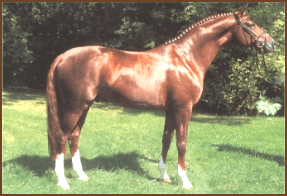
COMMON HORSE BREEDS
| HANOVERIAN
Origin: |
 Photo supplied by the Hanoverian Horse Society of Australia - Queensland © |
History:
In 1735 George II, King of England and Elector of Hannover established a state stud at
Celle, Germany. There quality stallions, mostly Holsteins, Andalusians and Neapolitans,
were lent to local people for breeding. Later English horses, including the Thoroughbred
where included to produce an all pursue horse, suitable for riding, light carriage and
farm work. At the end of the 18th century the stud had more than 100 stallions, but by
1816 after the Napoleonic wars only a third remained. More Thoroughbred horses were
imported to compensate for the losses which resulted in the Hanoverian becoming too light
for the work required and had to be corrected accordingly.
After World War II a demand for leisure horses developed and the Hanoverian was crossed
with the Thoroughbred and the Trakehner to produce a refined warmblood well suited for
equestrian sports. To be a licensed stallion Hanoverians, like other German warmbloods,
have to pass a veterinarian inspection and a ridden performance test.
Characteristics:
Head: medium sized, clean cut head; expressive, large, lively
eyes; good, free cheekbones
Neck: long, fine
Shoulders: large, sloping with prominent withers
Body: strong, deep body; muscular hindquarters
Legs: well muscled limbs; large, prominent joints
Feet: hard, well formed hooves
Tail: well set
Color: all solid colours
Height: 15.3 to 16.3hh
Temperament: good, kind
Qualities: strength, energetic action
Today:
Hanoverians are extremely popular as dressage and show jumping horses
because of their great strength, energetic action and good temperament.
![]()